INDEX
- English
- 日本語

Heijo-kyu Toin Teien in Nara City, which opened in 2003 after archaeological excavations and restoration - English
- 日本語

Sogenchi Pond in the garden of Tenryuji Temple in Kyoto
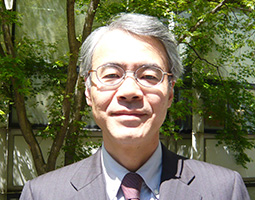
Prof. Dr. Naka Takahiro, Kyoto University of the Arts, director of the Research Center for Japanese Garden Art and Historic Heritage 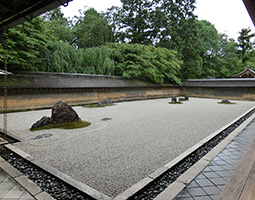
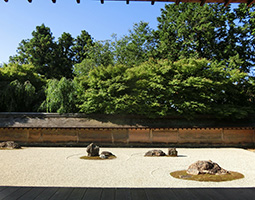
Dry landscape garden in Ryoanji Temple 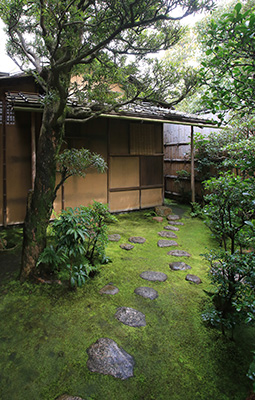
Omotesenke Fushin’an in Kyoto. Note the tobiishi stepping stones in the roji garden leading to the teahouse 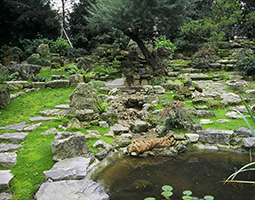
The Japanese garden at Schönbrunn Palace in Vienna
May 2021
Japanese Gardens as “Living Organisms”

Various kinds of gardens have been created all over Japan since ancient times. We interviewed Naka Takahiro, Kyoto University of the Arts, director of the Research Center for Japanese Garden Art and Historic Heritage, about the characteristics and history of Japanese gardens.
What are the characteristics of Japanese gardens?
European gardens, which like Japanese gardens have a long history, are mainly formal gardens whose designs are based on geometric forms such as straight lines and squares. Japanese gardens, by contrast, are natural landscape gardens designed to imitate the natural landscape. The key elements of Japanese gardens are water, rocks and plants. These elements are used not only to reduce the scale of the natural landscape, but also to express thoughts and stories. For example, water symbolizes rivers, waterfalls, and oceans, while rocks symbolize mountains and animals, and white sand symbolizes oceans and clouds. The evergreen pine tree represents eternal life. Japanese people have created gardens that imitate the natural landscape because Japan is abundant in beautiful natural landscapes featuring oceans, islands, rivers and mountains, and people have revered them.
Approximately when were Japan’s old gardens created?
There are many theories, but it is believed that the old gardens were created in the sixth or seventh century. In the eighth century, large gardens were created at the then capital Heijo-kyo (present-day Nara City and surrounding areas). One of them is Toin Teien (East Palace Garden) of Heijo-kyu (Nara Palace). Restored after archaeological excavations and opened to the public in 2003, Toin Teien is one of the oldest examples of a natural landscape garden, with its pond and rocks representing a coastal landscape. The garden has a pond with some islands in the center, which are thought to have been modeled on islands said to be inhabited by immortal hermits*.

Natural landscape gardens flourished in the capital of Kyoto during the Heian period from the late eighth century to the late twelfth century. A classic example is Byodoin Temple Garden. Byodoin was established in 1052 by the nobleman Fujiwara Yorimichi (992–1074). At that time, there was a widespread Buddhist belief among the aristocracy that worshipping Amida Buddha could secure passage to the Pure Land (Buddhist paradise) after death. Byodoin Temple Garden represents the world of the Pure Land, and a statue of the seated Amida Buddha is enshrined in the Amida-do Hall (Phoenix Hall) built on an island in the center of the pond.
What kind of Japanese gardens were created later?
From around the thirteenth century, karesansui (dry landscape) gardens influenced by the philosophy of Zen Buddhism became widespread. Karesansui gardens are devoid of water, and use rocks and white sand to represent natural scenery such as mountains, islands, oceans and clouds. The gardens of Ryoanji Temple, Daisen-in Zen Temple, and Saihoji Temple in Kyoto are famous examples of karesansui gardens.


The karesansui garden of Saihoji Temple was created by the Zen monk Muso Soseki (1275–1351). Muso Soseki founded various temples and committed to create gardens across Japan. Tenryuji Temple in Kyoto is one example. Japanese gardens make use of a technique called shakkei (borrowed landscape), in which elements of the surrounding landscape become part of the garden landscape. The garden in Tenryuji uses the technique by “borrowing” the scenery of mountains such as Mt. Arashiyama. Rocks of assorted sizes are placed around the Sogenchi Pond in the center of the garden. Ryumonbaku (Dragon's Gate Waterfall) consists of only a number of rocks arranged to represent a carp climbing up a fast-flowing waterfall (the waterfall today is dry) and transforming into a dragon, which is said to represent the Zen teaching that one must practice asceticism continually to attain enlightenment.

As chanoyu (the way of tea) grew in popularity in the sixteenth century, roji (dewy ground) gardens began to be built at the entrance to teahouses. Roji gardens imitate the landscapes of the forest village, creating a path that leads guests out of the real world and into the teahouse, itself regarded as another world. In the roji garden, artificial elements are kept to a minimum and “simple beauty,” which is one of chanoyu’s basic philosophies, is expressed. For example, tobiishi (stepping stones) are placed in the roji garden to prevent the guests’ footwear from becoming soiled on the way to the teahouse, but at the same time the shape and placement of the stones themselves enhance the beauty of the garden.

Japanese gardens can now be found around the world. What led to the construction of Japanese gardens overseas?
A major catalyst was World Expos. A Japanese garden created by Japanese artisans was exhibited for the first time in Europe at the Vienna World’s Fair in 1873, and the response was overwhelming. Later, Japanese gardens were exhibited at World Expos in France and the United States. These World Expo exhibits led to Japanese gardens becoming well-known in the West.
One of the Japanese gardens in Europe is located in the gardens of Schönbrunn Palace in Vienna. It was created by a Viennese court engineer who was impressed by the Japanese garden exhibited at the Royal International Horticultural Exhibition in Chelsea, England in 1912. But after the Second World War, the garden was abandoned for a long time. I participated in the research and restoration that took place over a period of around two years starting in 1998. In the course of the research, it became clear that the garden was a fusion of the characteristics of Japanese gardens, which use many stones, and European gardens, which use many flowers. I was extremely impressed by the fact that such a garden had been created around a century ago without any help from the Japanese.

What aspect of Japanese gardens would you like people overseas to pay particular attention to?
Japanese gardens have been changing over their long history. Some plants will grow big, while others will wither and be re-planted. Rocks too change shape or lean when exposed to the elements. Japanese gardens are just like living organisms. Once the spread of COVID-19 subsides, I would like many people from overseas to see for themselves these “living organisms” and feel their vitality. I would like them to “engage in dialogue” with the gardens. Japanese gardens have been created from a variety of thoughts. Even looking at the same garden, there is no single interpretation of those thoughts. The interpretation differs from person to person. Rather than focusing on beauty alone, the viewer can deepen their own interpretation by engaging in a dialogue with the garden, asking themselves what it is the garden is asking of them. In this way, the pleasure of looking at a Japanese garden will be enhanced.
* There is a theory that the design represents an idea from Shenxian thought originating in ancient China that humans can become immortal hermits.

